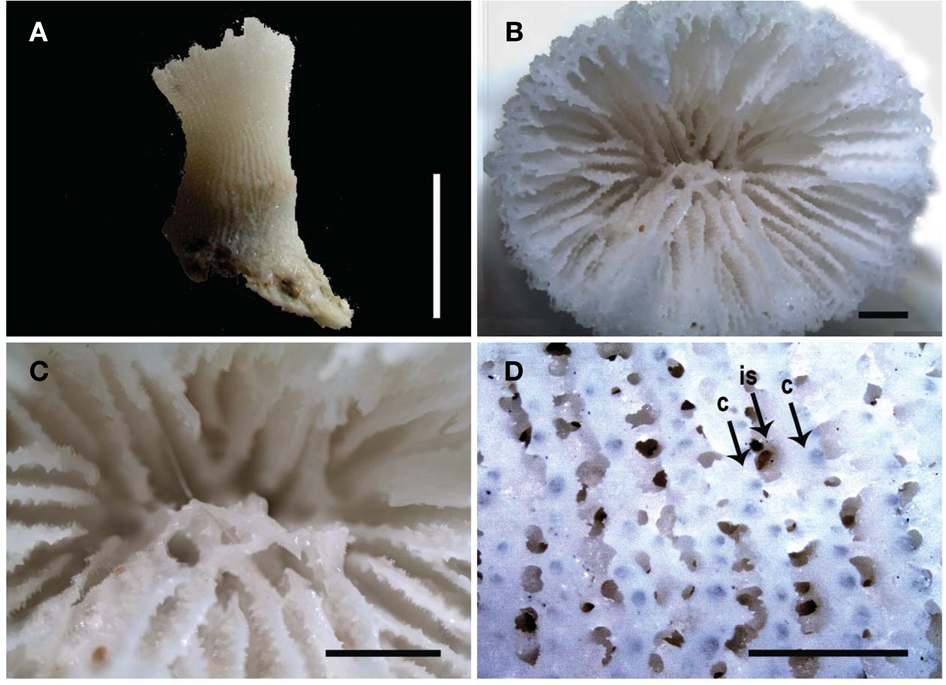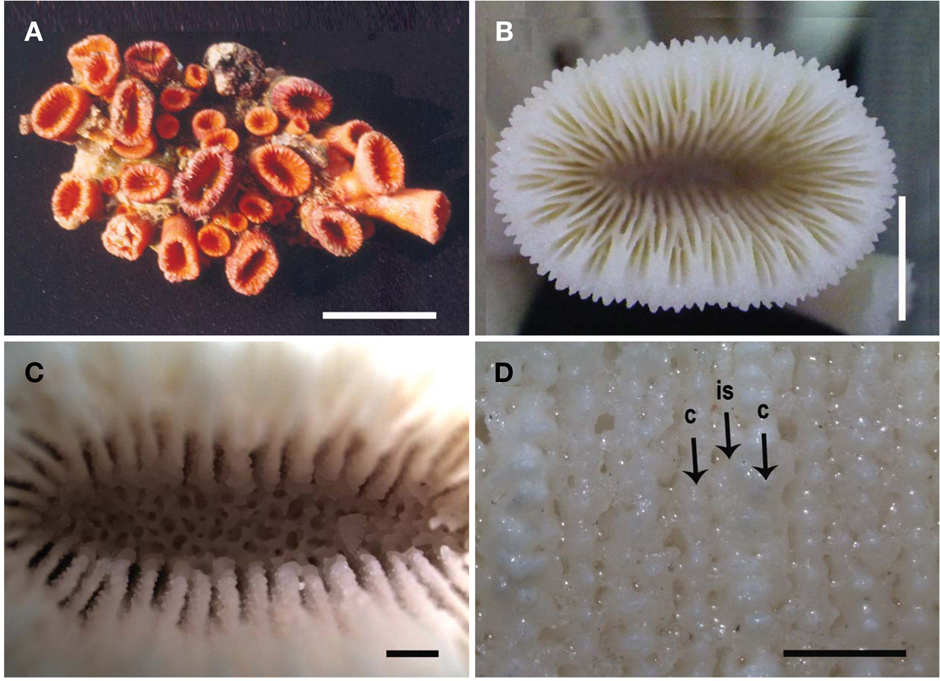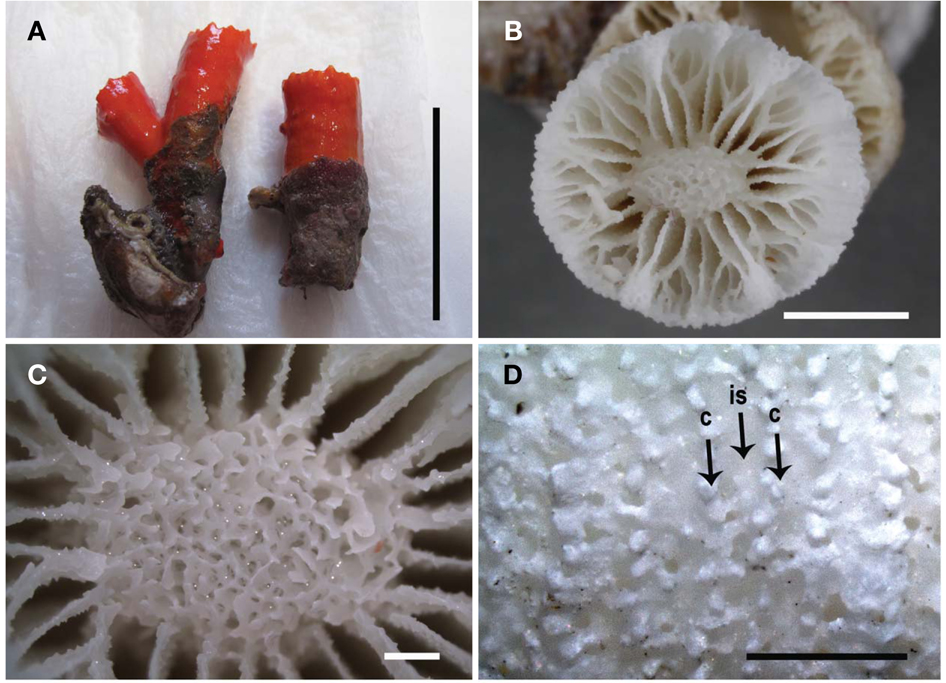



The family Dendrophylliidae Gray, 1847 includes 20 genera and approximately 150 species (Daly et al., 2007). It accounts for 10% of 1,488 species in the order Scleractinia, and 21% of 711 azooxanthellate scleractinian corals (Roberts et al., 2009). Dendrophylliids occur worldwide except in Antarctic regions at depths from the intertidal zone to 2,165 m, but most commonly at depths of 50-300m (Cairns, 2001). The family Dendrophylliidae is characterized by its synapticulotheca with septa of one fan system. Seven species and three subspecies of four genera in the family have been reported from Korean waters since 1982 (Song, 1982, 1988, 1991, 1994, 2004; Song and Lee, 1998). The two newly recorded genera in Korea,
The specimens were collected from the subtidal zones of Mara-do, Beomseom, Munseom, and Supseom in Jeju-do Island, Korea by SCUBA diving during the period from 1987 to 2012. The specimens were anaesthetized with menthol for 6-8 hours, and preserved in 70% ethanol. They were dissolved in sodium hypochlorite solution (Clorox: commercial bleach) with distilled water for 24 hours to remove all soft parts for skeletal structures, washed in distilled water, and dried. The figures of the corallums were photographed with digital cameras (G12; Canon Inc., Tokyo, Japan and Optio WG2; Pentax Ricoh Imaging Co. Ltd., Tokyo, Japan). The skeletal structures of the corallites such as septa, columella, and theca were observed under a stereomicroscope (Leica S8APO; Leica Microsystems, Wetzlar, Germany), photographed with a mounted camera (Leica Microsystems), and measured with an image analyzer (LAS ver. 3.6; Leica Microsystems). A series of multi-focused images were taken and combined by an image editing program (HeliconFocus 5.3 Pro; Helicon Soft Ltd., Kharkov, Ukraine) to obtain the clear images of detailed skeletal structures of septal arrangements, columella, and costae and intercostal striae. The present study partly followed Wells’ classification system of scleractinian corals (Wells, 1956). The terminology, and glossary of morphological and anatomical terms in this study were referenced from Wells (1956), Cairns (1994, 2001), and Cairns and Kitahara (2012). The specimens of the present study are deposited at the Ewha Womans University Zoological Systematics and Conservation Ecology Lab (EWZS), the Korean Coral Resource Bank (KCRB), and the Ewha Womans University Natural History Museum (EWNHMAN) in Korea.
Phylum Cnidaria Hatschek, 1888 Anthozoa Ehrenberg, 1834 Subclass Hexacorallia Haeckel, 1866 Order Scleractinia Bourne, 1900 Family Dendrophylliidae Gray, 1847
Diagnosis. Synapticulotheca developed. Septa of one fan system. Pourtalès plan usually developed.
Diagnosis. Corallum solitary or quasi-colonial, attached or free. Costae usually well developed. Synapticulotheca well developed. Pourtalès plan present. Columella spongy.
Diagnosis. Corallum solitary, turbinate, and attached. Synapticulotheca costate. Costae granulated. Pourtalès plan present. Columella elongate, spongy.
Milne Edwards and Haime, 1848 (Fig. 1)
Material examined. Korea: 2 inds., Jeju-do: Seogwipo-si, Munseom, 22 Jan 1998, Song JI, 20-25 m deep (EWZS 5190).
Description. Corallum solitary, attached. Corallite subturbinate with enlarged calice, slimmer lower part, and expanded basal part, 7×9 mm in calicular diameter, 7×7 mm in pedicel diameter, 8×16 mm in basal diameter, 10-19 mm in height. Calice circular or elliptical, irregular. Upper calicular margins compressed, enlarged. Columella rudimentary spongy interconnected by inner edges of septa, 0.5×1.8 mm in diameter. Fossa 6 mm in depth. Theca 0.17-0.56mm(average 0.33 mm) in thickness. Epitheca absent. Synapticulotheca developed in costae and intercostal striae. Costae linearly granulated, 0.12-0.33mm(average 0.21 mm) in width. Costal granule 0.03-0.12 mm (average 0.08 mm) in diameter. Intercostal striae irregularly porous. Synapticulae 0.06-0.27 mm (average 0.13 mm) in length, 0.12-0.29 mm (average 0.22 mm) in width. Intercostal pore 0.09-0.48 mm (average 0.21 mm) in length, 0.09-0.26 mm (average 0.18 mm) in width. Septa hexamerously arranged with 48 in 4 complete cycles. Pourtalès plan present. S1>outer S4≥S2>inner S4>S3. S1 closely aligned in parallel with its neighboring S4s. S1, S2, S3 straightly arranged. Outer S4 slightly curved toward S2. Pairs of S4s united before common S3. S1, outer S4 fused with columella. Inner edges of all septa vertical, straight. Inner edges of S2, S3 usually free, rarely fused. Upper margins of S1, S2 exsert. Outer thecal margins of S1, S2 thickened. Septal faces covered with small spines.
Habitat. The species inhabits subtidal zones of 20-25 m in depth.
Remarks. This species is characterized by its small low solitary corallite with enlarged calice, and expanded basal part. The specimen in the present study has small calicular diameter, hexamerous septa of 4 complete cycles, indistinctive pedicel, and rudimentary columella in comparison with the species in the previous descriptions (Milne Edwards and Haime, 1848; Cairns, 1994; Ogawa et al., 1998).
Distribution. Pacific Ocean: Korea (Jeju-do Island); Japan (Amami, Aomori, Jogashima Island, Minabe, Sagami Bay, Suruga Bay, Toyama Bay, Wakasa Bay); Phillippines.
Material examined. Korea: 3 inds., Jeju-do: Seogwipo-si, Seogwipo South Breakwater, 24 Jun 2005, Song JI (KCRB 226, 227, 228).
Description. Corallum quasi-colonial, attached. Growth form phaceloid of corallites basally united without main trunk, 20-50 mm in width, 30-35 mm in height. Extratentacular budding. Lateral branching once or twice from upper outer edges of axial corallite walls. Corallite compressed subturbinate (ceratoid to trochoid) with basal angle of 20-45° . Axial corallite 9×10-13×17 mm (average 11.3×15.0 mm) in calicular diameter, 7×9-9×13 mm (average 8.3×11.2 mm) in pedicel diameter, 12-35 mm (average 22.6 mm) in height. Lateral corallite 4×5-6×8 mm (average 5.0×6.3 mm) in calicular diameter, 4-8mm(average 5.3 mm) in height. Calice compressed, elliptical. Columella well developed oval spongy, 2.7×5.8-3.4×7.1 mm (average 2.8×6.8 mm) in diameter. Fossa 3-10mm(average 9.4 mm) in depth. Theca 0.38-0.88 mm (average 0.53 mm) in thickness. Epitheca absent. Synapticulotheca developed in costae and intercostal striae. Costae linearly granulated, 0.23-0.58 mm (average 0.33 mm) in width. Costal granule 0.07-0.26 mm (average 0.13 mm) in diameter. Intercostal striae irregularly porous. Synapticulae 0.10-0.45 mm (average 0.22 mm) in length, 0.10-0.29 mm (average 0.16 mm) in width. Intercostal pore 0.07-0.43 mm (average 0.20 mm) in length, 0.06-0.28 mm (average 0.14 mm) in width. Septa hexamerously arranged with 82-96 (average 88) in 5 cycles. Pourtalès plan present, but weakly, irregularly developed. S1≥S2>S3>S4≫S5. S1, S2 straightly arranged, entire, thick. Inner margins of S1, S2 straight, vertical. Outer thecal margins of S1, S2 thickened. S4, S5 often weakly developed. Pairs of S4s slightly curved or fused toward common S3, pairs of S5s slightly curved toward common S4. S1, S2, S3 fused with columella. Septal faces covered with small spines.
Habitat. Bryozoans, worm tubes, hydroids, and shells attach to the basal part of the corallum of the species.
Remarks. The species has been known as
Distribution. Pacific Ocean: Korea (Jeju-do Island); Japan (Amakusa Islands, Cape Shiono, Sagami Bay, Shirahama, Suruga Bay, Tokyo Bay); Indian Ocean: Maldive (Maldive Islands).
Diagnosis. Colonies phaceloid from common coenosteum. Branching rare. Pourtalès plan well developed. Columella spongy.
Material examined. Korea: 3 inds., Jeju-do: Seogwipo-si, Mara-do, 25 Oct 1991, Song JI, Won JH by SCUBA diving, orange (EWZS 4105).
Description. Corallum colonial, attached. Growth form phaceloid of corallites basally united without main trunk, 15-90 mm in width, 50-65 mm in height. Extratentacular budding from common basal coenosteum. Corallite cylindrical or subturbinate, 2.5×3.0-10.0×16.0 mm (average 10.0×15.0 mm) in calicular diameter, 6-40 mm (average 31 mm) in height. Calice strongly compressed, elongate, elliptical, but circular in young corallites. Columella elongate, deep, flat, spongy, 0.5×0.6-1.3×6.7 mm (average 1.0×5.4 mm) in diameter. Fossa 1.5-9.0 mm (average 9.0 mm) in depth. Theca 0.09-1.15 mm (average 0.58 mm) in thickness. Epitheca present at lower parts of some corallites or in young corallites. Synapticulotheca developed in costae and intercostal striae. Costae distinctive, linearly granulated, 0.12- 0.60mm(average 0.29 mm) in width. Costae of S1, S2 wider. Costal granule 0.02-0.60 mm (average 0.18 mm) in diameter. Intercostal striae porous. Synapticulae 0.07-0.35 mm (average 0.15 mm) in length, 0.06-0.24 mm (average 0.16 mm) in width. Intercostal pore 0.06-0.33mm(average 0.14 mm) in length, 0.05-0.23 mm (average 0.12 mm) in width. Coenosteum covered by calcareous substances. Septa hexamerously arranged with 33-96 (average 92) in 4-5 cycles, typically 5 cycles. Pourtalès plan present. S1=S2=S3>outer S5>inner S5>S4. S1, S2, S3, S4 straightly arranged, entire. Upper margins of S1, S2, S3 rounded. Inner edges of S1, S2, outer S5, S4 vertical, straight. Outer S5 united with inner S5 before common S4, extended to columella. S1 fused with its neighboring outer S5s, S2 with its neighboring outer S5s, S3 with its neighboring inner S5s at outer thecal margins. S1, S2, S3, outer S5 fused with columella. Septal faces covered with small spines.
Color. Coenosarc orange in living.
Habitat. Worm tubes, hydroids, and barnacles attach to the corallum of the species.
Remarks. The species is distinguished by its phaceloid growth form from common basal coenosteum, compressed corallites, elongate flat spongy columella, and thick theca.
Distribution. Pacific Ocean: Korea (Jeju-do Island); Japan (Hachijoujima Island, Manadzuru, Nakagi, Oshima Island, Shirahama, Tateyama); Hawaii (Hawaiian Islands); Australia (Queensland); Panama (Gulf of Panama); Columbia (Malpelo Island); Equador (Galápagos Islands).
Material examined. Korea: 1 ind., Jeju-do: Seogwipo-si, Munseom, 28 Dec 1987, Han HS, 15 m below deep (EWNHMAN 2030); 6 inds., Seogwipo-si, Beomseom, 22 Oct 1991, Song JI, Won JH by SCUBA diving, orange (EWZS 4120); 3 inds., Seogwipo-si, Mara-do, 25 Oct 1991, Song JI, Won JH by SCUBA diving (EWZS 4109); 1 ind., Seogwipo-si, Beomseom, 2 Jul 1993, Song JI, 20 m deep (EWNHMAN 473); 1 ind., Seogwipo-si, Munseom, 22 Jan 1998, Song JI (EWZS 5191); 2 inds., Seogwipo-si, Munseom, 20 Oct 1998, Song JI (EWZS 4110); 2 inds., Seogwipo-si, Beomseom, 3 Nov 2000, Korean Cultural Heritage Administration (EWZS 3978); 5 inds., Seogwipo-si, Mara-do, 4 Nov 2000, Song JI, 30 m deep (EWZS 3980); 2 inds., Seogwipo-si, Munseom, 7 Nov 2000, Korean Cultural Heritage Administration, 15-25 m deep (EWZS 3979); 10 inds., Seogwipo-si, Beomseom, 21 Feb 2001, Korean Cultural Heritage Administration, 26 m (EWZS 4119); 2 inds., Seogwipo-si, Beomseom, 6 Jun 2001, Song JI (EWZS 3982); 2 inds., Seogwipo-si, Beomseom, 6 Jun 2001, Song JI (EWZS 3984); 1 ind., Seogwipo-si, Supseom, 27 Jul 2006, Moon HY, Cho IY (EWZS 3981); 5 inds., Seogwipo-si, Beomseom, 7 Jan 2009, INTHESEA KOREA (EWZS 4144); 3 inds., Seogwipo-si, Beomseom, 23 Feb 2009, INTHESEA KOREA (EWZS 4145); 2 inds., Seogwipo-si, Beomseom, 23 Feb 2009, INTHESEA KOREA (EWZS 5192); 3 inds., Seogwipo-si, Beomseom, 16 Apr 2010, Song JI (EWZS 3854, 3855, 3856); 1 ind., Seogwipo-si, Beomseom, 9 Feb 2012, Song JI, Hwang SJ, orange (EWZS 5082).
Description. Corallum solitary or colonial, attached. Growth form cylindrical or phaceloid of corallites basally united without main trunk, 10-90 mm in width, 30-80 mm in height. Extratentacular budding from common basal coenosteum. Intratentacular budding rare. Corallite cylindrical, 2×2-14 ×15mm(average 10.0×10.9 mm) in calicular diameter, 1.5 -75.0 mm (average 26.3 mm) in height. Lateral branching rare, irregular, asymmetric, once or twice. If lateral branching present, axial corallite 9×10-13×15 mm (average 11.2×12.3 mm) in calicular diameter, 38-75mm(average 56 mm) in height, lateral corallite 5×5-11×12 mm (average 7.8×8.8 mm) in calicular diameter, 3-35 mm (average 17.5 mm) in height. Calice circular or elliptical. Columella elliptical, spongy, 0.6×1.2-4.0×10.0mm(average 6.7×10.2 mm) in diameter. Fossa 3-11mm(average 7.4 mm) in depth. Theca thin. Epitheca absent. Synapticulotheca developed in costae and intercostal striae. Costae linearly granulated, 0.11-0.38 mm (average 0. 23 mm) in width. Costal granule 0.04-0.18 mm(average 0.08 mm) in diameter. Intercostal striae porous. Synapticulae 0.05-0.32 mm (average 0.14 mm) in length, 0.06-0.37 mm (average 0.14 mm) in width. Intercostal pore 0.04-0.28 mm (average 0.12 mm) in length, 0.03-0.31 mm (average 0.11 mm) in width. Coenosteum costate. Septa hexamerously arranged with 40-114 (average 69) in 4-6 cycles, typically 5 incomplete cycles. Pourtalès plan well developed. S1>outer S5≥S2>inner S4>S3>inner S5>outer S4. S1, S2 straightly arranged. S1, S2, outer S5 fused with collumella. Outer S5 curved downward, fused with inner S5 before outer S4, extended to inner S4, curved toward S2. S1 fused with its neighboring outer S5s. S2 fused with its neighboring inner S4s at outer thecal margins. Upper margins of S1, S2 exsert. Septal faces covered with small spines.
Color. Coenosarc orange, tentacles yellow in living.
Habitat. The species inhabits subtidal zones of 15-30 m in depth. Sponges, hydroids, bryozoans, bivalves, oyster shells, worm tubes, and barnacles attach to the basal part of the corallum of the species.
Remarks. This species is characterized by its phaceloid growth form of cylindrical corallites budding from common basal coenosteum, and the distinctive flower-pattern Pourtalès plan. The intratentacular budding of the species is observed in the present study.
Distribution. Pacific Ocean: Korea (Jeju-do Island); Japan (Bonin Islands, Hachijoujima Island, Kushimoto, Sagami Bay, Shirahama); China; Indo-West Pacific; Australia.



